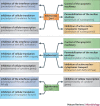Viral security proteins: counteracting host defences
- PMID: 21060318
- PMCID: PMC7096814
- DOI: 10.1038/nrmicro2452
Viral security proteins: counteracting host defences
Abstract
Interactions with host defences are key aspects of viral infection. Various viral proteins perform counter-defensive functions, but a distinct class, called security proteins, is dedicated specifically to counteracting host defences. Here, the properties of the picornavirus security proteins L and 2A are discussed. These proteins have well-defined positions in the viral polyprotein, flanking the capsid precursor, but they are structurally and biochemically unrelated. Here, we consider the impact of these two proteins, as well as that of a third security protein, L(*), on viral reproduction, pathogenicity and evolution. The concept of security proteins could serve as a paradigm for the dedicated counter-defensive proteins of other viruses.
Conflict of interest statement
The authors declare no competing financial interests.
Figures



References
Publication types
MeSH terms
Substances
LinkOut - more resources
Full Text Sources
Medical

